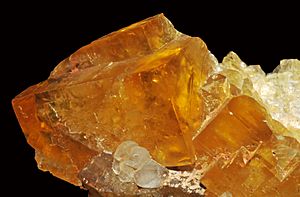Fluoride facts for kids
Fluoride is a special form of the chemical element fluorine. Think of it like this: when fluorine, which is very reactive, takes an electron from another substance, it changes into fluoride. This process is called reduction. Fluoride is super important because it helps keep our teeth strong and healthy, especially when it's in toothpaste. Sometimes, fluoride is also added to drinking water in certain areas. This practice, called fluoridation, has led to some discussions about whether the benefits for teeth outweigh any possible concerns.
Contents
What is Fluoride?
Fluoride is a negatively charged ion (a type of atom with an electrical charge) that comes from the element fluorine. Fluorine is a gas, but when it gains an electron, it becomes fluoride, which can then combine with other elements to form different compounds. These compounds are what we usually refer to as fluoride. For example, sodium fluoride is a common type of fluoride found in many products.
Fluoride and Your Teeth
One of the most well-known uses of fluoride is in dental care. It plays a big role in preventing tooth decay, also known as cavities. Here's how it works:
- Strengthens Enamel: Your tooth enamel, the hard outer layer of your teeth, can be weakened by acids produced by bacteria in your mouth. Fluoride helps to make the enamel stronger and more resistant to these acid attacks.
- Repairs Early Damage: If your enamel has started to weaken, fluoride can help to repair it by attracting other minerals, like calcium and phosphate, back to the tooth surface. This process is called remineralization.
- Fights Bacteria: Fluoride can also help to slow down the growth of harmful bacteria in your mouth that cause cavities.
You can get fluoride for your teeth from several sources, including fluoride toothpaste, mouthwashes, and professional fluoride treatments at the dentist's office.
Fluoride in Drinking Water
Adding fluoride to public drinking water supplies is a practice called fluoridation. It started in the mid-20th century after scientists noticed that people living in areas with naturally higher levels of fluoride in their water had fewer cavities.
- Why it's Done: The main goal of water fluoridation is to help prevent tooth decay across an entire community, especially for people who might not have regular access to dental care. It's seen as a way to improve public health.
- The Discussion: While many health organizations support water fluoridation because of its proven benefits for dental health, some people have concerns. They worry about potential health effects from consuming fluoride in water, or they believe individuals should have the choice whether or not to consume it. Scientists continue to study fluoride and its effects to ensure its safe use.
Where is Fluoride Found?
Besides toothpaste and some drinking water, fluoride is also found naturally in various places:
- Minerals: It's present in many minerals, like Fluorite, which is a natural fluoride mineral.
- Food and Drinks: Small amounts of fluoride can be found in some foods and drinks, such as tea, fish, and certain vegetables.
- Soil and Water: Fluoride is naturally present in soil and water in different concentrations around the world.
Related pages
- Fluorine
- Fluorite, a natural fluoride
- Fluoridation
Images for kids
See also
 In Spanish: Fluoruro para niños
In Spanish: Fluoruro para niños



